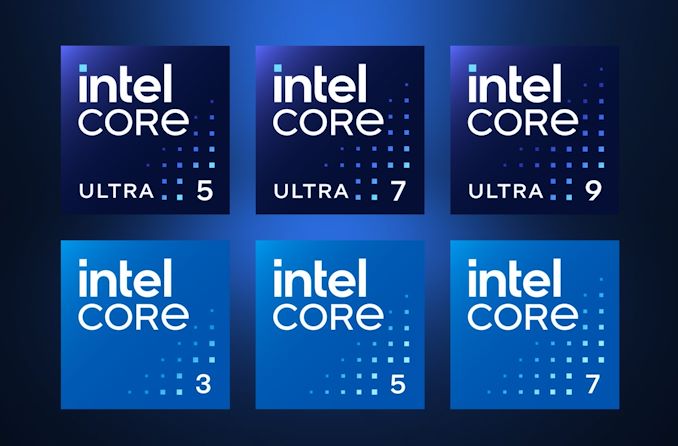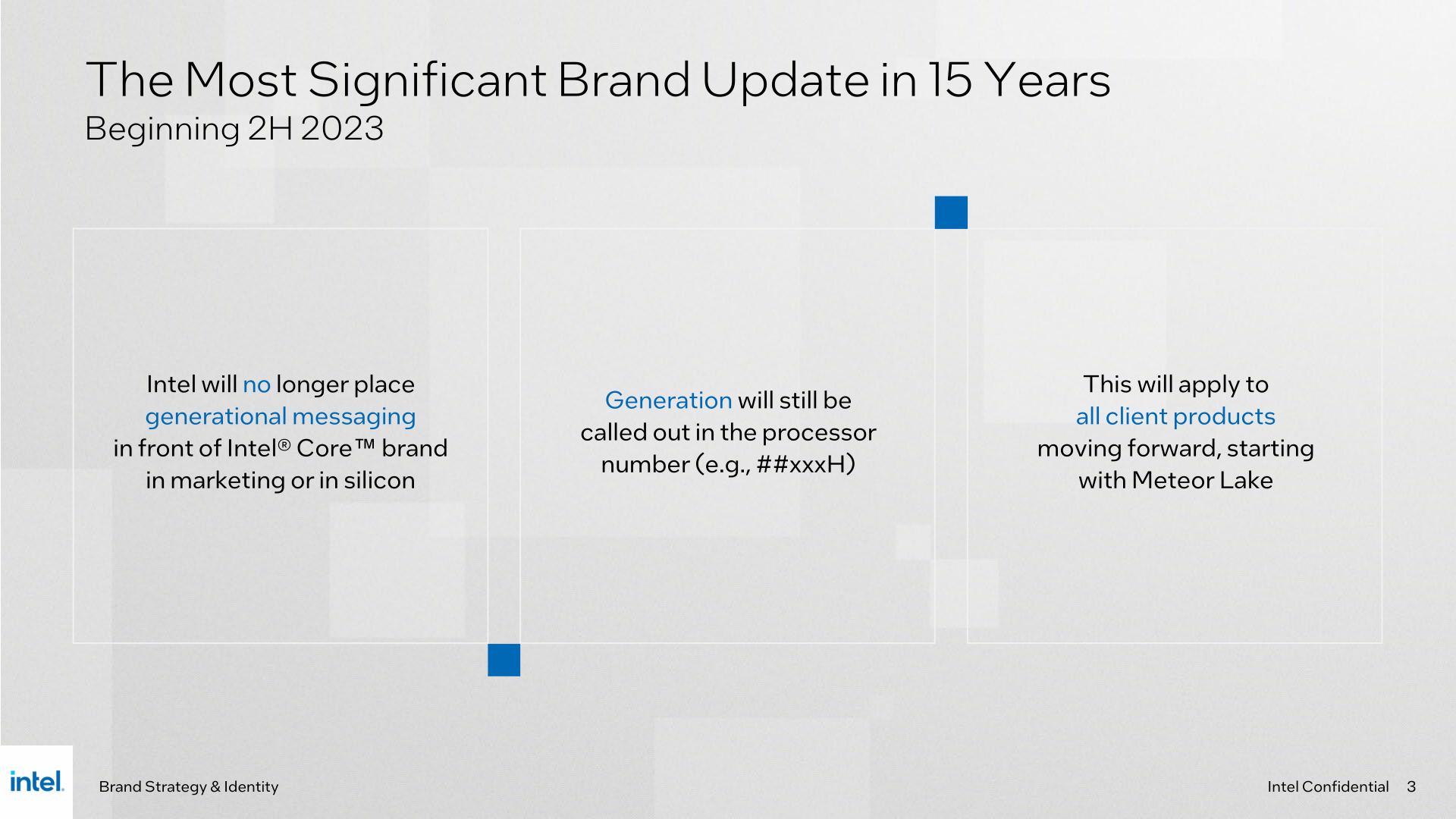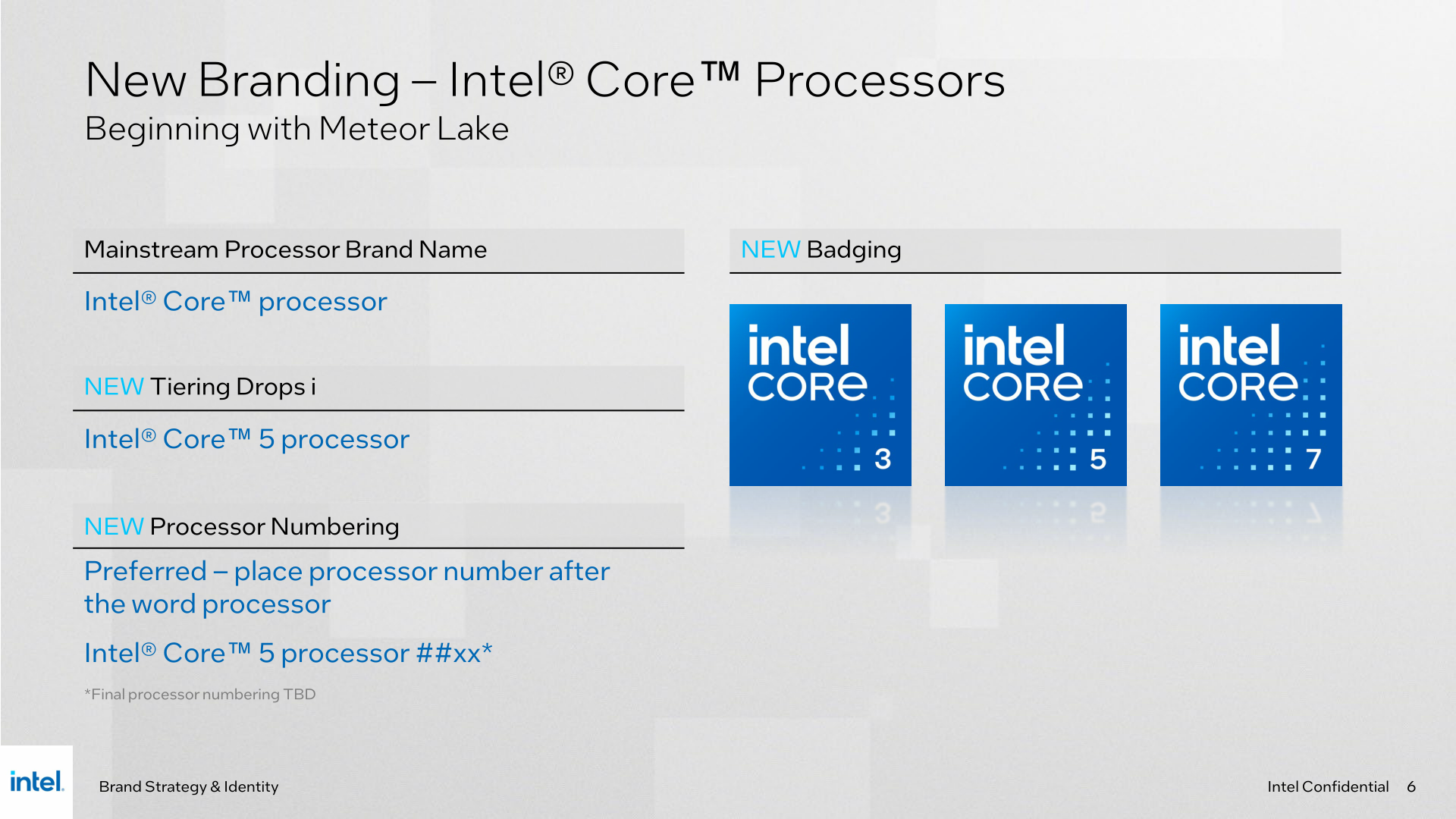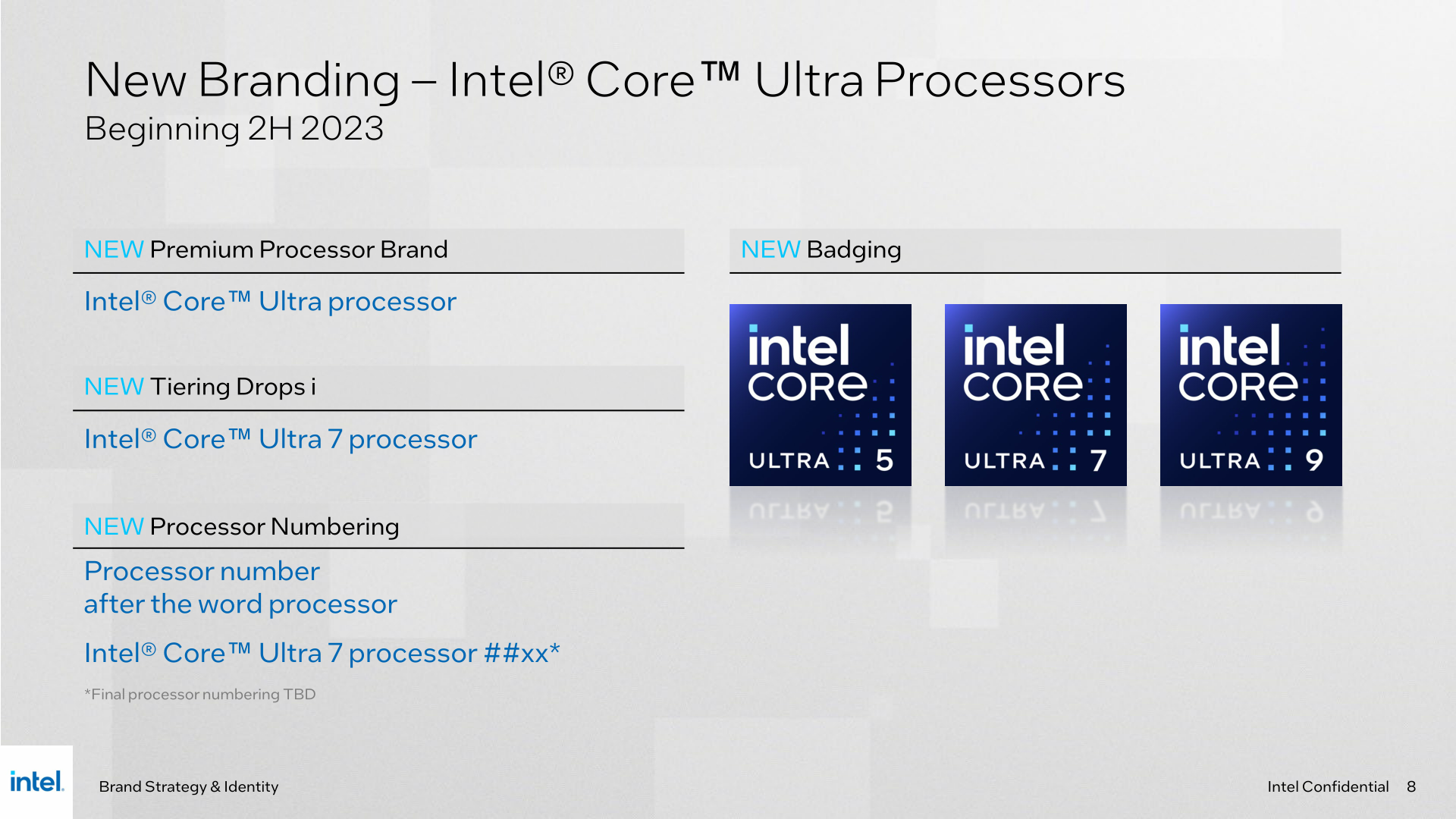Intel To Launch New Core Processor Branding for Meteor Lake: Drop the i, Add Ultra Tier
by Gavin Bonshor on June 15, 2023 9:00 AM EST
As first hinted at by Intel back in late April, Intel is embarking on a journey to redefine its client processor branding, the biggest such shift in the previous 15 years of the company. Having already made waves by altering its retail packaging on premium desktop chips such as the Core i9-11900K and Core i9-12900K, the tech giant aims to introduce a new naming scheme across its client processors, signaling a transformative phase in its client roadmap.
This shift is due to begin in the second half of the year, when Intel will launch their highly anticipated Meteor Lake CPUs. Meteor Lake represents a significant leap forward for the company in regards to manufacturing, architecture, and design – and, it would seem, is prompting the need for a fresh product naming convention.
The most important changes include dropping the 'i' from the naming scheme and opting for a more straightforward Core 3, 5, and 7 branding structure for Intel's mainstream processors. The other notable inclusion, which is now officially confirmed, is that Intel will bifurcate the Core brand a bit and place its premium client products in their own category, using the new Ultra moniker. Ultra chips will signify a higher performance tier and target market for the parts, and will be the only place Intel uses their top-end Core 9 (previously i9) branding.
Intel: A Brief History of the Core i Series
The Core i series debuted in 2008, around 15 years ago, marking the end of the first Core/Core 2 era and signaling a new dawn for Intel's client product lines. This change happened alongside the release of its 45 nm manufacturing process through the Nehalem architecture and covered products such as Celeron, Pentium Core, and the Xeon brands. More recently, in 2020, Intel initiated a more comprehensive overhaul of its corporate identity to modernize the messaging from a 50 year old company, the effects of which are still winding through the company today.
This revamp of Intel's branding has involved the introduction of new trademarks and logos characterized by cleaner typography and simplistic geometric backgrounds with a lighter blue color scheme. As part of this process, Intel has previously bid farewell to its long-established budget CPU brands, Pentium and Celeron. These branding changes were undoubtedly intended to convey a willingness to change, transcend, and solidify their position in an emerging market.
Going from the older Core Duo branding to the Core i3 series marked the dawn of Intel's modern low-end processor branding, with the quantitative markup of their other lineups into the Core i5 (mid-range) and the Core i7 series – which at the time, was reserved for Intel's flagship processors.
Going Forward: Deemphasizing Generational Branding
The latest branding change, as previously mentioned, is the biggest in the last 15 years of Intel. While some naming schemes can be confusing and cluttered (ahem, Xeons), Intel is aiming for something that's still reasonably clear for the client processors. Which is great timing, because the hardware underpinning them is about to get fairly complex with the transition chiplet-based Meteor Lake and its mix-and-match of dies built on the Intel 4 process and built over at rival-supplier TSMC.
First and foremost, under their new branding system Intel is doing away with leading generational branding. For the last decade plus, we've seen Intel slowly increment through their Core generations, such as 4th Gen Core, 9th Gen Core, 13th Gen Core, etc. Often, this was placed in front of the processor description (especially on OEM devices), giving us descriptions such as "Intel 11th Generation Core i3".
Under Intel's new branding change, the processor generation is being deemphasized – but not eliminated entirely. The processor model numbers themselves will still start with the generation as they do today, but that will be the only place where the generation will be consistently denoted. Generation as a leading indicator will be going away.
At this point, we don't know where Intel will start their latest numbering system from. While Intel could very well continue on from where they've left off, making the next parts the 14th Generation (and thus 14xxx model numbers), more likely Intel is going to use this as a chance to reset their generation count. The benchmark data leaks that caused Intel to initially comment on this matter back in April included mention of a 1003H chip, for what that's worth.
Intel Core 3, Core 5, and Core 7 for Mainstream: Dropping the Iconic 'i'
As part of the new rebranding, Intel is dropping the 'i' from their processor tiering system for client processors, starting with Meteor Lake and other products on the roadmap beyond this. This means that the Core i3, i5, and i7 naming structure becomes Core 3, 5, and 7, effectively dropping the 'i' moniker of the naming structure.
This means chips such as the Core i5 13600 would be named something like Core 5 13600 under the new naming convention. This doesn't constitute a massive change in the naming, but is significant as the 'i' has been an iconic moniker for its processors over the last 15 years.
Notably here, this tier of Core branding is what Intel considers their "mainstream" processors. It doesn't cover Core 9 in any way – that tier is reserved for Intel's premium "Ultra" brand.
Intel Core Ultra: Reserved For Premium Chips - Core Ultra 5, Ultra 7, and Ultra 9
Intel is also officially splitting off its premium client chips into their own sub-brand of sorts, giving them the new Ultra label. Intel's Core Ultra branding is reserved for their "premium" processors, which the company isn't strictly defining what that means in advance. So how this will fit into the Meteor Lake generation of processors remains to be seen. Though on the desktop, we wouldn't be the least bit surprised to see this replace (or go hand-in-hand with) Intel's traditional K/KS series SKUs.
Reading between the lines here, it's interesting to note that, unlike Intel's slide for mainstream processors, which says "Beginning with Meteor Lake", Intel's Ultra changes are "Beginning 2H 2023". There is still a lot of cloudiness within Intel's client chip roadmap when it comes to their desktop processor plans for the next year, and how Meteor Lake may (or may not) fit into those. So this slight distinction on when the branding begins may be a sign that Intel isn't intending to launch high-end Meteor Lake desktop processors – opening the door to a Raptor Lake refresh or the like.
Finally, following Intel's intended processor numbering scheme in the future, for both mainstream and Ultra chips, the processor model number will be after the word "processor". Intel's example is "Intel Core Ultra 7 processor [model number]" which isn't too much dissimilar to the current structure, albeit with the word 'Ultra' thrown in for good measure. This is to signify the target market of the processor, similar to how Intel used the Extreme moniker for their Core X-series processors.
Intel's Meteor Lake Cometh In H2'2023
The shift to the new branding and effectual removal of the 'i' from the said branding is interesting. While processor sales have declined over the last few years, the COVID-19 pandemic, the war in Ukraine, and a general economic downturn have worsened matters. It remains to be seen whether or not these new changes are designed to promote an uptick in sales, e.g., selling more chips, or whether or not they represent making a change due to the massive generational shift in how Intel will be fabbing its processors – both with regards to chiplets and the EUV-enabled Intel 4 process.
With Meteor Lake not expected to splash down from the skies until later in 2023 for mobile and perhaps later on (if at all) in 2024 for desktop chips, Intel's latest Intel 4 process represents a massive shift in Intel's processor technologies. Meteor Lake is the first in Intel's arsenal to use EUV lithography in the manufacturing process, including using a similar approach to using both performance (P) and efficiency (E) cores, much like we've seen from both Alder Lake (12th Gen) and the current Raptor Lake (13th Gen) processors.
Without diving much too into the meat of Meteor Lake and the advancements of what Intel 4 and TSMC's own processes bring to the table, our detailed coverage of Intel's upcoming Meteor Lake processors can be found below:
- Intel Discloses New Details On Meteor Lake VPU Block, Lays Out Vision For Client AI
- Intel Details PowerVia Chipmaking Tech: Backside Power Performing Well, On Schedule For 2024
- Intel Meteor Lake Client Processors to use Arc Graphics Chiplets
- Intel: Meteor Lake & Intel 4 Process Now Ramping for Production




















45 Comments
View All Comments
Kamen Rider Blade - Friday, June 16, 2023 - link
IMO, Intel should've changed their branding to:Generation Value = [##]
- Core ULTRA = Consumer DeskTop CPU's ONLY = [##]###<Letter>
- Core Mobile = Consumer Mobile CPU's ONLY = [##]##<Letter>
- Core Pentium = PROfessional (DeskTop or Mobile) CPU's ONLY with PROfessional feature sets
- Core Celeron = Consumer NAS/Low Power Terminal Computers for simple computing.
Core Pentiums are for Professionals in a large company.
Other Core products are for Consumers.
Potential new Model Numbering Scheme:
= DeskTop = 14###K
= Mobile = 14##U
seamonkey79 - Friday, June 16, 2023 - link
= Server = 14###I= Enthusiast = 14###F
= Mobile = 14##U
= DeskTop = 14###K
mganai - Thursday, June 22, 2023 - link
F = graphics chip fused offK = unlocked processors (desktop or mobile)
U = 15 W mobile
Xeon Max/Platinum/Gold/Silver/etc.= Server
Xeon w# = Workstation
PeachNCream - Friday, June 16, 2023 - link
Yeah, I can't say that I care much either way about what a company uses to name its product stack. The specs like performance and power consumption versus the price are the only factors that make a difference so Intel can use whatever naming convention and it means exactly nothing whatsoever to me aside from taking a few minutes to learn a new product stack.Tamdrik - Saturday, June 17, 2023 - link
Even if I'm able to pick out which chips are superior to others relatively quickly with a bit of research, it still bothers me when the product naming is clearly trying to confuse less-savvy customers in order to pawn off older stock. One would think a Ryzen 5 7520U would be superior to a Ryzen 3 7440U based on the branding, but the latter has higher clocks, more cache, a better iGPU, and is two generations newer with the same number of cores/threads. At least the Intel branding seems to be more transparent.TEAMSWITCHER - Saturday, June 17, 2023 - link
It's still terrible. The only company branding their CPU products well right now is Apple. M2, M2 Pro, M2 Max, and M2 Ultra are perfectly clear.meacupla - Wednesday, June 21, 2023 - link
Yeah. I'm still confused as to which is supposed to be the fastest in that product stack.Is it the ultra or the max?
uuu - Thursday, July 13, 2023 - link
I'd prefer M2 Max, Maxer, and Maxest.olde94 - Saturday, June 17, 2023 - link
so what is better, core 7 or ultra 5?this doesn't help consumers at all....
Hresna - Saturday, June 17, 2023 - link
Dr Cutress used to have good stories about intel eng vs marketing…This is almost like marketing’s real goal here wasn’t to make it easier for consumers but something else entirely… what could it be…